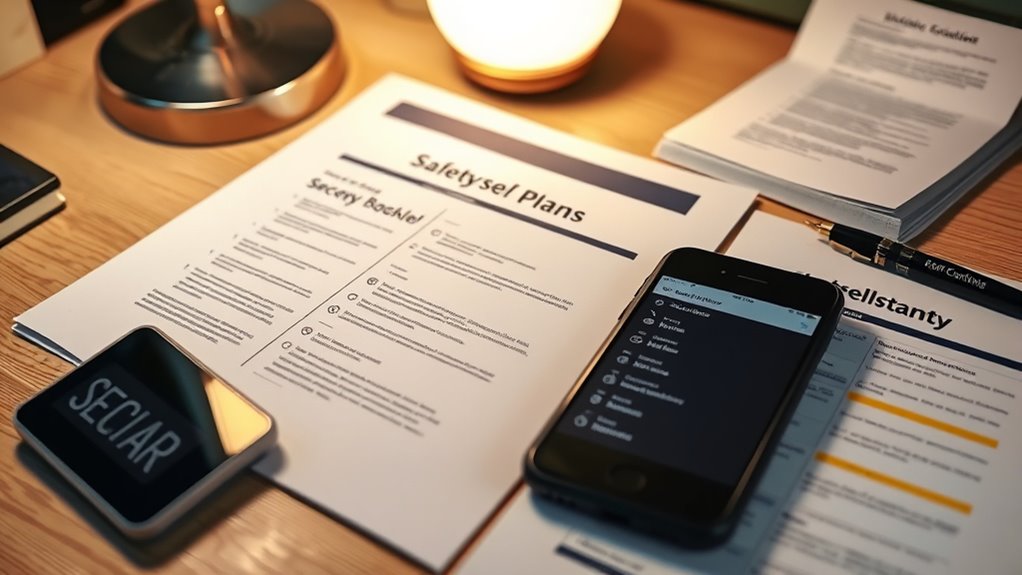To stay safe when leaving an abusive situation and during legal proceedings, gather emotional support from trusted people and create a detailed safety plan. Identify the best times to exit, prepare an emergency bag, and inform someone about your plans. Work with an attorney or support organization to understand your legal rights and secure protective orders. Always prioritize your well-being by coordinating safety measures and ensuring you have ongoing support as you navigate this challenging process. If you keep exploring, you’ll find even more strategies to stay safe.
Key Takeaways
- Conduct a thorough safety assessment and develop a quick exit plan with emergency supplies.
- Coordinate with trusted individuals and use a pre-arranged code word to signal danger.
- Schedule legal proceedings at times when safety can be maximized, and request protective orders.
- Arrange secure transportation to court and avoid contact with the abuser during legal visits.
- Seek emotional support through counseling and support groups to strengthen resilience throughout the process.

Leaving an abusive situation and steering legal proceedings can be overwhelming and dangerous without proper planning. You might feel a whirlwind of emotions—fear, anger, relief—but staying focused on safety is crucial. Before taking any steps, it’s essential to gather emotional support from trusted friends, family members, or professionals who can provide encouragement and guidance. Having someone to lean on can help you stay grounded during this challenging time.
A vital part of your safety planning is conducting a thorough safety assessment. This means carefully evaluating your environment, identifying potential risks, and planning how to minimize them. Think about your current living situation, the abuser’s behavior patterns, and any warning signs that could escalate violence. Your safety assessment should include developing a plan to leave quickly if needed, such as packing an emergency bag with essentials—clothing, important documents, phone chargers, and medications—and knowing the safest routes to leave your home.
When you’re ready to leave, timing is critical. Choose a time when the abuser is less likely to be home or distracted. If possible, inform a trusted person about your plans so they can check in on you or provide immediate support if needed. Keep your phone charged and accessible at all times, and consider having a code word that signals danger to friends or family. Remember, your emotional support network isn’t just there for comfort; they can also help execute safety plans or assist during legal proceedings.
Legal processes add another layer of complexity and risk, so it’s important to coordinate with a knowledgeable attorney or support organization. They can help you understand your rights, prepare necessary documents, and navigate court procedures safely. As part of your safety plan, think about how you’ll attend hearings—perhaps arranging transportation in a way that limits contact with your abuser or scheduling it at times when you’re most protected. It’s also wise to request security measures or court orders, like a protective order, to help keep your abuser at a distance during legal proceedings.
Throughout this process, prioritize your emotional well-being. Seek counseling or support groups that understand domestic abuse—these resources can bolster your resilience and help you manage the stress of leaving and maneuvering legal steps. Remember, safety isn’t just about physical security; emotional strength plays a vital role in your ability to move forward. By combining a detailed safety assessment with a strong emotional support network, you can create a plan that empowers you and reduces risks, giving you a better chance to start fresh and rebuild your life. Understanding legal rights can also be crucial in ensuring your safety during legal proceedings.
Frequently Asked Questions
How Do I Access Emergency Shelters Quickly?
To access an emergency shelter quickly, call local helplines or hotlines that provide immediate assistance. Keep a list of nearby shelters and their contact info handy. Use safety tips like having a packed bag ready, knowing your route, and informing someone you trust about your plans. Many shelters have emergency contact numbers or websites you can visit for quick support, ensuring you get help fast when you need it most.
What Legal Documents Should I Carry During Departure?
Think of your departure as steering a ship through stormy seas—you’ll need your lighthouse guiding you. Carry essential legal documents like court orders, safety plans, identification, and any custody papers. These act as your navigational tools, ensuring you stay on course and protected. Keep copies in a secure, accessible place, and always have them on hand when leaving, so you can swiftly prove your rights and safety measures to authorities if needed.
How Can I Ensure My Safety Online During Legal Processes?
To guarantee your safety online during legal processes, prioritize your online privacy and digital security. Use strong, unique passwords for all accounts and enable two-factor authentication whenever possible. Avoid sharing sensitive information on unsecured networks or social media. Regularly update your software and security settings, and consider using a VPN to protect your browsing activities. Stay vigilant about phishing scams and monitor your accounts for any suspicious activity to stay safe.
Are There Financial Resources Available for Safety Planning?
Yes, you can find financial aid and community support to help with safety planning. Local shelters, nonprofit organizations, and government programs often offer emergency funds, transportation assistance, or legal aid. Reach out to these resources to access financial help tailored to your situation. Connecting with community support can provide both emotional reassurance and practical resources, making your safety plan stronger and more achievable during this difficult time.
How Do I Involve Children in Safety Preparations?
Have you considered how child involvement can make safety planning more effective? You should include your children in age-appropriate safety discussions, ensuring they understand basic safety rules without causing fear. Talk openly, listen to their concerns, and practice safety routines together. This helps them feel empowered and prepared. Remember, involving children in safety preparations fosters trust and confidence, making everyone more resilient during challenging times.
Conclusion
Remember, your safety is your strongest shield. By planning carefully and gathering support, you can navigate this challenging time with confidence. Never underestimate the power of a solid plan—it’s like a safety net that catches you when fears try to pull you under. Stay vigilant, stay strong, and believe in your resilience. You’re not alone in this fight; with determination, you’ll emerge stronger than ever, turning the storm into a calm that’s yours to command.










